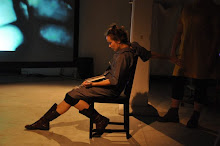The problem in this case, is that Gertrude Stein is so much more than simple language. Stein's libretto, which is baffling and endearing all at once, does battle with the very narrative conventions in which she works. Halfway into Scene 1, a singer announces "Scene Three," followed two lines later by "Scene Four," followed by a reassertion in the chorus that we are, in fact, still in "Act One." But Stein's contradictoriness, and her gentle challenges to narrativity don't quite make it onto the stage. When on a single page we learn that "Saint Teresa not seated," "Saint Teresa not seated at once," that "Saint Teresa once seated" and "Saint Teresa seated and not surrounded," Morris's gestural logic reaches an impasse. He can't recreate contradiction, so he ignores these lines altogether.
Of course, no one would expect any choreographer to stage each and every tiny fluctuation in Stein's poetry. "If it were possible to kill five thousand chinamen by pressing a button would it be done" translated to stage could quickly become a sketch from Whose Line is it Anyway? The problem with Morris's choreography isn't that it doesn't capture all the nuances of Stein's poetry. The problem is that it lacks the freedom to break rules the way Stein's poetry does, including the freedom to break with the libretto the way the libretto breaks with itself. Why not seat St. Teresa on these lines? Why not seat someone on St. Teresa, and someone on top of both of them? Why not create a pile St. Teresas? Why not have St. Teresa lie down on these lines, or exit? Why not interrupt scenes with other scenes, the way Stein does? Why not create scenes that have nothing to do with the libretto? The problem, in my view, is that Morris wants to be captive to a libretto that only infrequently yields sensical onstage pictures and relationships. When the libretto goes where he cannot go, he seems to run out of ideas. In particularly awkward moments, the dancers enact a kind of ordered chaos that looks like what Lewis Carroll might have envisaged for his Lobster Quadrille.
To be fair to Morris, Virgil Thomson is a big part of the problem. His score is oddly chipper, as though trapped in the world of Copland's Rodeo, which had premiered three years earlier. The upbeat positivity of the score is at times so overwhelming it becomes almost parodic, as though it were channeling Arthur Sullivan. To be sure, Thomson is very aware of the more beautiful moments in Stein's libretto, and thankfully so. "Can women have wishes," "It is very easy to love alone" and "There can be no peace on earth with calm" are stunningly poignant moments of choral stasis. (Trinity Choir, by the way, with the exception of a few, minor hiccups, is excellent.) Still, one has the feeling again and again that Stein's minimalism was way ahead of Thomas and that Philip Glass would have been a fitter collaborator.
When Four Saints is successful, it is when gesture is allowed to assume equal partnership with the music and the text, and to make decisions on its own. Violating the logic that a closing curtain means "scene," for instance, at the end of Act II a dancer flings himself triumphantly through the curtain and takes a kind of Chariots of Fire lap around the stage. Or, the first time St Ignatius enters, he side-steps on tip-toe as fast as he can, crossing the stage in its entirety and unceremoniously disappears again. In really rare moments, gesture even rises above music to tell us more than music alone can. In Beethoven's Fantasia in C Minor for Piano, Chorus and Orchestra, the second piece on the program, there is a moment where we expect a giant flourish from the piano, which builds to a climactic forte ... and then falls silent. Onstage, a dancer enters, preparing to leap into cadenza-like frenzy. But then, hearing nothing further, she quickly glances around and ducks offstage as though to escape the embarrassment of an accidental entrance. In this brilliant maneuver, the dancer's confusion articulates our own confusion almost before we know we've felt it.
My favorite moment on the entire program is the famous "pigeons on the grass alas" line, where we finally get to see (or so I imagine) why Morris chose to do Four Saints in the first place. The chorus sings, nonsensically, and with gusto: "They might be very well very well very well they might be they might be." Suddenly, as if given permission do what it had wanted to do all along, the male chorus suddenly breaks into a swaggering barn dance like something straight out of Oklahoma! This is immediately followed by a group of women strutting across the stage to "Let Lucy Lily Lily Lucy Lucy let Lucy Lucy Lily Lily Lily Lily Lily." The audience burst into laughter, and from the faces of the dancers, it was clear that the moment made sense to them too. It was as if, in letting go of all pretense to English, the libretto signalled that finally it was okay to be silly. And it worked because finally Mark Morris wasn't afraid to be Mark Morris. If only there were more of him in this production.




No comments:
Post a Comment